EVERY CAR-MANUFACTURING COUNTRY of any note has produced a top marque at some time or other. Rolls-Royce established a peak in this context for Britain, France had the Hispano-Suiza, Italy produced the Isotta-Fraschini in vintage times and Ferrari and other exotics since the war, Germany had top models from Mercedes, and America has contributed great and splendid automobiles such as the Duesenberg, Packard, Cadillac and Lincoln.
Sylvain de Jong
Belgium was never a major builder of cars, but if it did not make them in vast quantities, it had its grande marque in the celebrated Minerva, the Goddess of Automobiles. It all began in 1897 when Sylvain de Jong commenced making bicycles and then branched out into supplying engines for the first motor cycles, a venture in which he was so well regarded that most of Europe's pioneer riders were propelled by little Minerva engines.
Using his own expertise, de Jong had dabbled with a primitive motor car and a lorry before the close of the century and, by 1900, was sensibly making motor cycles of his own. Serious car manufacture was begun by the Antwerp factory in 1904 following experiments, a couple of years before this, with a four-cylinder 6 hp unit which was based on the Panhard system of a front-mounted engine driving the rear wheels.
These initial production Minervas were soundly constructed but by no means revolutionary machines. They used T-head engines and, by starting with a twin-cylinder unit and adding cylinders to it, a primarily 1.6-liter model could be made available as a 2½-liter with three cylinders, or as a bigger four-cylinder car of over 3 liters capacity.
The Minervette
It might be thought that, at this early period of the automobile movement, de Jong would have been happy to have three sound models with which to entice customers. But, perhaps because Belgium was scarcely a wealthy country, the Minerva Company also ventured into the realms of cyclecar construction.
They called this very simple device the Minervette. It used a single- cylinder engine, of a mere 636 cc, at the front of a chassis and a simple transmission which consisted of a two-speed gearbox and final drive, driving to one of a pair of back wheels by a chain. Fortunately for the reputation of Belgium and the future fortunes of the Minerva concern, this did not prevent proper cars of increasing horsepower emerging from the works of the Company, which was known as Minerva Motors SA of Antwerp.
The Hon C. S. Rolls, of Rolls-Royce fame, began to sell Minerva cars in London, and it may have been his influence which brought more powerful models into the catalogues and showrooms. At all events, it was a 14 hp 3-liter Minerva that attracted the interest of Rolls, rather than the little twin-cylinder and four-cylinder models. The shaft-driven Minerva Fourteen was a modestly priced, well sprung car of decent performance. It had a pressed-steel frame instead of the wooden frames used by the original chain-driven Minervas and it was possible to buy one in London, with body, ready to use, for only £285.
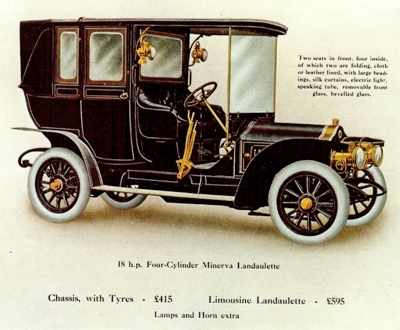 An early Minerva advertisment, showing the 18hp four cylinder Landaulette of 1908.
An early Minerva advertisment, showing the 18hp four cylinder Landaulette of 1908.
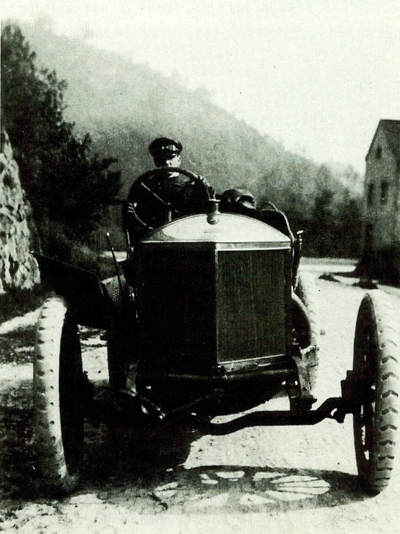 The "V" radiatored Minerva 1907 Racer. These cars were fitted with 8 liter engines featuring overhead inlet valves and five bearing crankshafts. Their attempt to win the Kaiserpreis was unsuccessful. At the Circuit des Ardennes however, where this picture was taken, the cars scored a great triumph by taking first, second, third and sixth places.
The "V" radiatored Minerva 1907 Racer. These cars were fitted with 8 liter engines featuring overhead inlet valves and five bearing crankshafts. Their attempt to win the Kaiserpreis was unsuccessful. At the Circuit des Ardennes however, where this picture was taken, the cars scored a great triumph by taking first, second, third and sixth places.
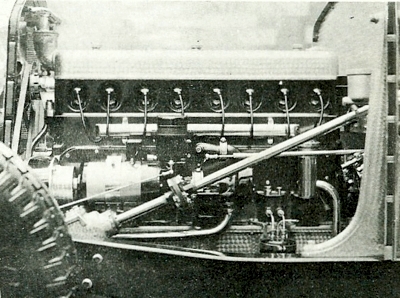 Minerva in-line 6600cc 40 hp eight cylinder engine, circa 1929.
Minerva in-line 6600cc 40 hp eight cylinder engine, circa 1929.
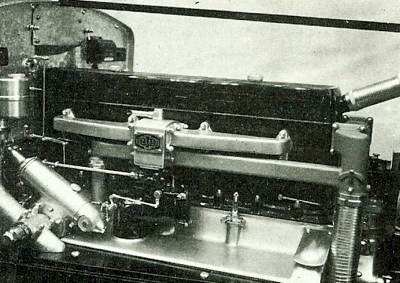 Minerva in-line four cylinder engine, circa 1930.
Minerva in-line four cylinder engine, circa 1930.
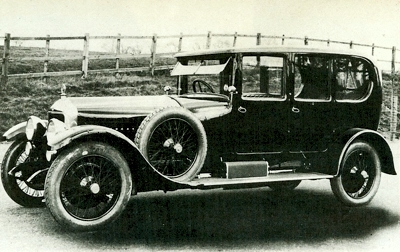 Minerva four-door six-cylinder 30hp of 1925.
Minerva four-door six-cylinder 30hp of 1925.
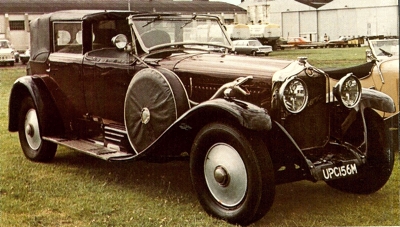 Known as "The Goddess of Automobiles", this photo shows a Minerva coupe de ville of the early 1930's.
Known as "The Goddess of Automobiles", this photo shows a Minerva coupe de ville of the early 1930's. |
The Minerva Racing Sixty
This was enough to put the name of this Belgian car firmly on the European map, and the Antwerp' Directors enhanced the Minerva reputation still further by sanctioning motor racing. They had brought out a fast Sixty in 1907 and led on from this to building a team of racing cars for the Kaiserpreis race that year. Unfortunately, they were unsuccessful, although fielding special cars with overhead inlet valves and five-bearing crankshafts. Two of the drivers were Moore-Brabazon (later Lord Brabazon of Tara) and Algy Lee Guinness; Brabazon later took his Minerva to the opening Brooklands meeting, only to have it catch fire.
However, in the Circuit des Ardennes race, Brabazon finished first, and he was followed home by Koolhoven and Guinness with Warwick Wright taking sixth place, all in Minervas. This was a nice walk-over for de Jong and for a time, he continued to make conventional big-engined four-cylinder Minervas, such as the 5.0-liter; there was also a very good 102 x 115 mm 3.7-liter car capable of exceeding 50 mph.
Adopting Charles Y. Knight's Design
After establishing itself as a sound poppet-valve car, the Minerva followed Daimler in adopting the double-sleeve-valve engine of the American inventor, Charles Y. Knight. By 1910, after a brief period when L-head side-valve cars had been made alongside the new valveless ones, all Minervas, as all Daimlers, were to the new, silent, if smoky, pattern. It was from this sleeve-valve basis that the well remembered Minerva top models emanated.
Something historians debate is whether Daimler or Minerva were first with a Knight-engined car in their catalogues. Whatever the truth, both companies did start a trend with a 38 hp model, powered by big four-cylinder engines of 124 x 130 mm. Dual ignition and trough-and-dipper lubrication were common to both these makes that had come under the Knight engine spell.
Anyway, the formula worked. King Albert was a customer for a 37 hp Minerva in the year of its introduction and smaller models, like the 2.3-liter 16 hp and a 4½-liter 26 hp Minerva, were immediately available for lesser mortals who wished to come under the sleeve-valve spell and smoke screen. These Knight Minervas now began to assume the luxury image that the post-war models are associated with.
Minerva's Race in Sweden, Russia, New Zealand and Spain
Magnificent closed bodies with every possible convenience were normal, and yet these were fast cars which began to demonstrate their reliability and pace in many of the more important trials and rallies, in places as far afield as Sweden, Russia, New Zealand and Spain. The big 'fours' carried on, acquiring improved cooling and lubrication as the years rolled on. The famous 38 hp Minerva was enlarged until it had a swept volume of 7.4 liters. It was an imposing car, with a wheelbase of 11 ft 4 in, but was less expensive than a contemporary Daimler just prior to the outbreak of war, and much less expensive than the Silver Ghost Rolls-Royce, that was still wedded to valves-and-tappets.
Minerva was now on the crest of a financial wave. Motor-cycle manufacture had ceased in 1910 and, before the Kaiser stopped play, the Belgian Company was offering the 75 x 120 mm Fourteen to its less-affluent supporters. In the UK, it sold for £340 as a chassis from the newly opened show-rooms at Minerva House in Chenies Street, in the heart of London.
There was also a brave attempt to prove the sleeve-valve system in racing, with a team of Minerva’s entered for the 1914 Tourist Trophy race in the Isle of Man. These were very special 3.3-liter cars, able to give 70 bhp at 2800 rpm, with a safe engine limit of 3300 rpm. They were driven in the contest by Riecken, Porporato and Molon, and went round blinding others with great smokescreens! They were not fast enough to vanquish the winning
Sunbeam, however, but this TT appearance was a convincing demonstration of Minerva reliability, and of faith in the L valve system that they had adopted four years earlier. They took second, third and fifth places.
The War Years
The war years were occupied with making vehicles for the Army, including armoured cars, until the factory was overrun. With the Armistice, de Jong was ready to resume where he had left off, using machine tools imported from America and his own coach-building shop at Mortel. In the latter respect, Minerva again paralleled Daimler, and soon had a reputation for making dull, dateless carriages which were, nevertheless, extremely well built. They were comfortable and elegant, although a Minerva was usually a more ponderous beast than a Rolls-Royce, except in its more sporting manifestations, or when endowed with other people's bodywork.
The Minerva 20 hp NN Type
The first of the post-war models to foster this tradition was the 20 hp NN type, with neat mono bloc cylinders and the expected cantilever rear springs of a heavy and sedate car. This was the 1919 offering. But, by 1921, a 5.3-liter six-cylinder model was ready. Not much development work was deemed necessary, although the cone clutch gave way to a single-plate type, and the former foot-operated transmission brake was changed for hand- operated rear-wheel retardation. Minerva engines were farmed out to a few other manufacturers, and in 1922 a small brother to the big Minervas appeared, in the form of the Type TT. This had a sleeve-valve motor of under 2 liters capacity and, as with the small Rolls which was to appear in 1923, a central lever to change gear with.
Mainly, however, the Minerva reputation lay with large cars, but these offered good value for money. The 30 hp six-cylinder followed natural processes of development, such as being provided with front-wheel brakes in 1923. There were various model permutations down the years, including a 2-liter 'small six' which was an 'Americanised' version of the larger cars, but retaining their seven-bearing crankshaft. In time, cast-iron sleeves gave way to steel ones, which gave the Type AK 32/34 hp model (which replaced the long-established 30 hp) quite a good performance, helped by its engine size of almost six liters.
Oil radiators and dual-choke carburetors followed and the new-found sporting image was acknowledged when a team of AK Minervas was entered for the 24-hour race at Spa. Even after the death of de Jong in 1928, Minerva flourished, and progressed along the lines of Daimler and Lanchester. That is to say that a long line of small and larger sixes was augmented in 1930 by a straight-eight, which used sleeve valves. It had a 90 x 130 mm engine, a wheelbase of 12 ft 9t in, and was surely the only model-it was known as the Type AL - on which the outsize steering wheel favored by Minerva did not look quite so enormous!
You could buy a limousine in London for £1875, with servo brakes, the back springs now being half-elliptics. It is remarkable how strong the similarity between Daimler and Minerva was. In London, Daimler Hire was well known and the London Minerva agents copied this with Minerva Hire. But, alas, the end was in sight: the English Company was bankrupt by 1932. The last Minerva was the 2 liter M4 of 1934 but it did not sell well.
With the financial crisis in the 1930s, the company was restructured as Société Nouvelle Minerva but in 1934 merged with the other major Belgian constructor Imperia. Imperia continued to make Minervas for a year and the AP until 1938 and from 1937 badged some of their cars and trucks for export to England and France as Minerva-Imperias. Just before the outbreak of the war, a group of businessmen from Verviers bought out Minerva.
After World War 2 the company produced Land Rovers under license for the Belgian army up to 1953. There were plans to re-enter the car market but these did not get beyond the prototype stage. The company struggled for survival and made the Continental-engined Land Rover-like C20 until 1956. Today the Minerva name is almost always associated with some of the world's finest town-carriages, especially in 32/34 and straight- eight form.
